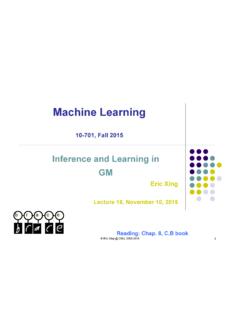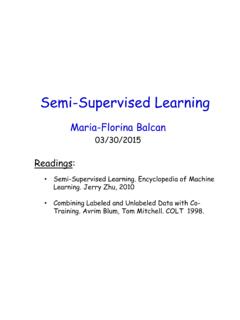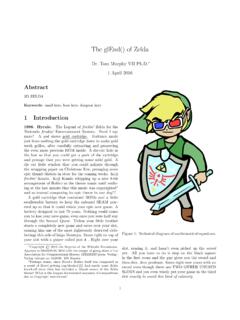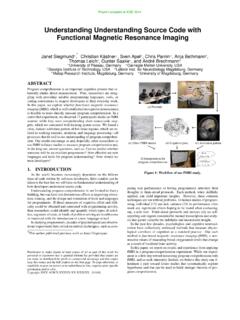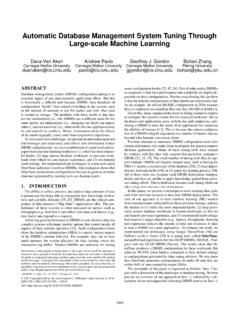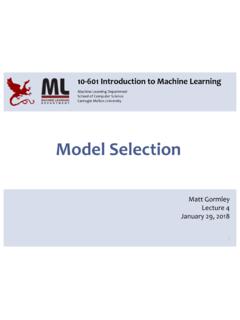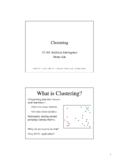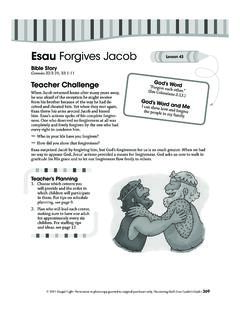Transcription of 23 Patterns in 80 Minutes: a Whirlwind Java- centric Tour ...
1 23 Patterns in 80 minutes : a Whirlwind java - centric Tour of the Gang-of-Four Design Patterns Josh Bloch Charlie Garrod School of Computer Science 15-214 1. Administrivia Homework 6 checkpoint due Friday 5 pm Final exam Tuesday, May 3, 5:30-8:30 pm, PH 100. Final review session Sunday, May, 7-9 pm, DH 1112. 15-214 2. Key concept from Tuesday . MapReduce with key/value pairs (Google style). Master Assign tasks to workers Ping workers to test for failures Map workers the shuffle: Map for each key/value pair Emit intermediate key/value pairs 15-214 3. Key concept from Tuesday . MapReduce with key/value pairs (Google style). , for each word on the Web, count the number of times that word occurs For Map: key1 is a document name, value is the contents of that document For Reduce: key2 is a word, values is a list of the number of counts of that word f1(String key1, String value): f2(String key2, Iterator values): for each word w in value: int result = 0;. EmitIntermediate(w, 1); for each v in values: result += v.
2 Emit(key2, result);. Map: (key1, v1) (key2, v2)* Reduce: (key2, v2*) (key3, v3)*. MapReduce: (key1, v1)* (key3, v3)*. MapReduce: (docName, docText)* (word, wordCount)*. 15-214 4. Outline I. Creational Patterns II. Structural Patterns III. Behavioral Patterns 15-214 5. Pattern Name Intent the aim of this pattern Use case a motivating example Key types the interfaces that define pattern JDK example(s) of this pattern in the JDK. 15-214 6. Illustration Code sample, diagram, or drawing Time constraints make it impossible to include illustrations from some Patterns Some Patterns lack an illustration L. 15-214 7. I. Creational Patterns 1. Abstract factory 2. Builder 3. Factory method 4. Prototype 5. Singleton 15-214 8. Abstract Factory Intent Allow creation of families of related objects independent of implementation Use case look-and-feel in a GUI toolkit Key type Factory with methods to create each family member JDK Not common 15-214 9. Builder Intent Separate construction of complex object from representation so same creation process can create different representations Use case converting rich text to various formats Key types (Abstract) Builder GoF has extra layer of indirection ( Director ).
3 JDK StringBuilder, StringBuffer*. But both produce String And most builders in the JDK are concrete 15-214 10. My take on Builder Emulates named parameters in languages that don't support them Reduces exponential O(2n) creational methods to O(n) by allowing them to be combined freely, at the cost of an intermediate (Builder) object 15-214 11. Builder Illustration NutritionFacts twoLiterDietCoke = new (. "Diet Coke", 240, 8).sodium(1).build();. public class NutritionFacts {. public static class Builder {. public Builder(String name, int servingSize, int servingsPerContainer) { .. }. public Builder totalFat(int val) { totalFat = val; }. public Builder saturatedFat(int val) { satFat = val; }. public Builder transFat(int val) { transFat = val; }. public Builder cholesterol(int val) { cholesterol = val; }.. // 15 more setters public NutritionFacts build() {. return new NutritionFacts(this);. }. }. private NutritionFacts(Builder builder) { .. }. }. 15-214 12. Factory Method Intent abstract creational method that lets subclasses decide which class to instantiate Use case creating documents in a framework Key types Creator, which contains abstract method to create an instance JDK not common.
4 (). Related Static Factory pattern is very common Technically not a GoF pattern, but close enough 15-214 13. Factory Method Illustration public interface Iterable<E> {. public abstract Iterator<E> iterator();. }. public class ArrayList<E> implements List<E> {. public Iterator<E> iterator() { .. }.. }. public class HashSet<E> implements Set<E> {. public Iterator<E> iterator() { .. }.. }. 15-214 14. Prototype Intent Create an object by cloning another and tweaking as necessary Use case writing a music score editor in a graphical editor framework Key types Prototype (AKA Cloneable). JDK clone, but don't use it (except on arrays). java and Prototype pattern are a poor fit 15-214 15. Singleton Intent ensuring a class has only one instance Use case GoF say print queue, file system, company in an accounting system Compelling uses are rare but they do exist Key types Singleton JDK 15-214 16. Singleton Illustration public enum Elvis {. ELVIS;. public sing(Song song) { .. }. public playGuitar(Riff riff) {.}}
5 }. public eat(Food food) { .. }. public take(Drug drug) { .. }. }. 15-214 17. My take on singleton It's an instance-controlled class; others include Static utility class (non-instantiable). Enum one instance per value, all values known at compile time Interned class one canonical instance per value, new values created at runtime There is a duality between singleton and static utility class 15-214 18. II. Structural Patterns 1. Adapter 2. Bridge 3. Composite 4. Decorator 5. Fa ade 6. Flyweight 7. Proxy 15-214 19. Adapter Intent convert interface of a class into one that another class requires, allowing interoperability Use case numerous, , arrays vs. collections Key types Target, Adaptee, Adapter JDK (T[]). 15-214 20. Adapter Illustration Have this and this? Use this! 15-214 21. Bridge Intent Decouple an abstraction from its implementation so they can vary independently Use case portable windowing toolkit Key types Abstraction, Implementor JDK JDBC, java Cryptography Extension (JCE).
6 Both are Service Provider Interface (SPI) frameworks SPI is Bridge Implementor! 15-214 22. Bridge Illustration 15-214 23. Composite Intent Compose objects into tree structures. Let clients treat primitives & compositions uniformly. Use case GUI toolkit (widgets and containers). Key type Component that represents both primitives and their containers JDK 15-214 24. Composite Illustration public interface Expression {. double eval(); // Returns value String toString(); // Returns infix expression string }. public class UnaryOperationExpression implements Expression {. public UnaryOperationExpression(. UnaryOperator operator, Expression operand);. }. public class BinaryOperationExpression implements Expression {. public BinaryOperationExpression(BinaryOperator operator, Expression operand1, Expression operand2);. }. public class NumberExpression implements Expression {. public NumberExpression(double number);. }. 15-214 25. Decorator Intent attach features to an object dynamically Use case attaching borders in a GUI toolkit Key types Component, implement by decorator and decorated JDK Collections ( , Synchronized wrappers), streams, Swing components 15-214 26.
7 Decorator Illustration 15-214 27. Fa ade Intent Provide a simple unified interface to a set of interfaces in a subsystem GoF allow for variants where the complex underpinnings are exposed and hidden Use case any complex system; GoF use compiler Key types Fa ade (the simple unified interface). JDK 15-214 28. Facade Illustration Subsystem classes Facade .. 15-214 29. Flyweight Intent use sharing to support large numbers of fine-grained objects efficiently Use case characters in a document Key types the Flyweight (instance-controlled!). State can be made extrinsic to keep Flyweight sharable JDK Pervasisve! All enums, many others. has # units as extrinsic state. 15-214 30. Flyweight Illustration 15-214 31. Proxy Intent surrogate for another object Use case delay loading of images till needed Key types Subject, Proxy, RealSubject Gof mention several flavors virtual proxy stand-in that instantiates lazily remote proxy local representative for remote obj protection proxy denies some ops to some users smart reference does locking or ref.
8 Counting, JDK RMI, collections wrappers 15-214 32. Proxy Illustrations Virtual Proxy aTextDocument anImageProxy image anImage fileName data in memory on disk Smart Reference Remote Proxy Client Server Proxy SynchronizedList ArrayList 15-214 33. III. Behavioral Patterns 1. Chain of Responsibility 2. Command 3. Interpreter 4. Iterator 5. Mediator 6. Memento 7. Observer 8. State 9. Strategy 10. Template method 11. Visitor 15-214 34. Chain of Responsibility Intent avoid coupling sender to receiver by passing request along until someone handles it Use case context-sensitive help facility Key types RequestHandler JDK Classloader, Properties Exception handling could be considered a form of Chain of Responsibility pattern 15-214 35. Command Intent encapsulate request as object, letting you parameterize clients with different actions, queue or log requests, etc. Use case menu tree Key types Command (an execute method). JDK Runnable, executor framework Is it Command pattern if you run it more than once?
9 If it takes an argument? Returns a val? 15-214 36. Interpreter Intent Given a language, define class hierarchy for parse tree, recursive method to interpret it Use case regular expression matching Key types Expression, NonterminalExpression, TerminalExpression JDK no uses I'm aware of Our expression evaluator (HW2) is a classic example Necessarily uses Composite pattern! 15-214 37. Interpreter Illustration public interface Expression {. double eval(); // Returns value String toString(); // Returns infix expression string }. public class UnaryOperationExpression implements Expression {. public UnaryOperationExpression(. UnaryOperator operator, Expression operand);. }. public class BinaryOperationExpression implements Expression {. public BinaryOperationExpression(BinaryOperator operator, Expression operand1, Expression operand2);. }. public class NumberExpression implements Expression {. public NumberExpression(double number);. }. 15-214 38. Iterator Intent provide a way to access elements of a collection without exposing representation Use case collections Key types Iterable, Iterator But GoF recognize internal iteration too JDK Collections, for-each statement, etc.
10 15-214 39. Mediator Intent Define an object that encapsulate how a set of objects interact to reduce coupling. O(n) couplings instead of O(n!) = O(2n). Use case dialog box where change in one component affects behavior of others Key types Mediator, components JDK Unclear 15-214 40. Mediator Illustration 15-214 41. Memento Intent Without violating encapsulation, allow client to capture an object's state, and restore Use case undo stack for operations that aren't easily undone, , line-art editor Key type Memento (opaque state object). JDK none that I'm aware of (not serialization). 15-214 42. Observer Intent Let objects observe the behavior of other objects so they can stay in sync Use case multiple views of a data object in a GUI. Key types Subject ( observable ), Observer GoF are agnostic on many details! JDK Swing, left and right 15-214 43. State Intent use an object internally to represent the state of another object; delegate method invocations to the state object Use case TCP Connection (which is stateful).
